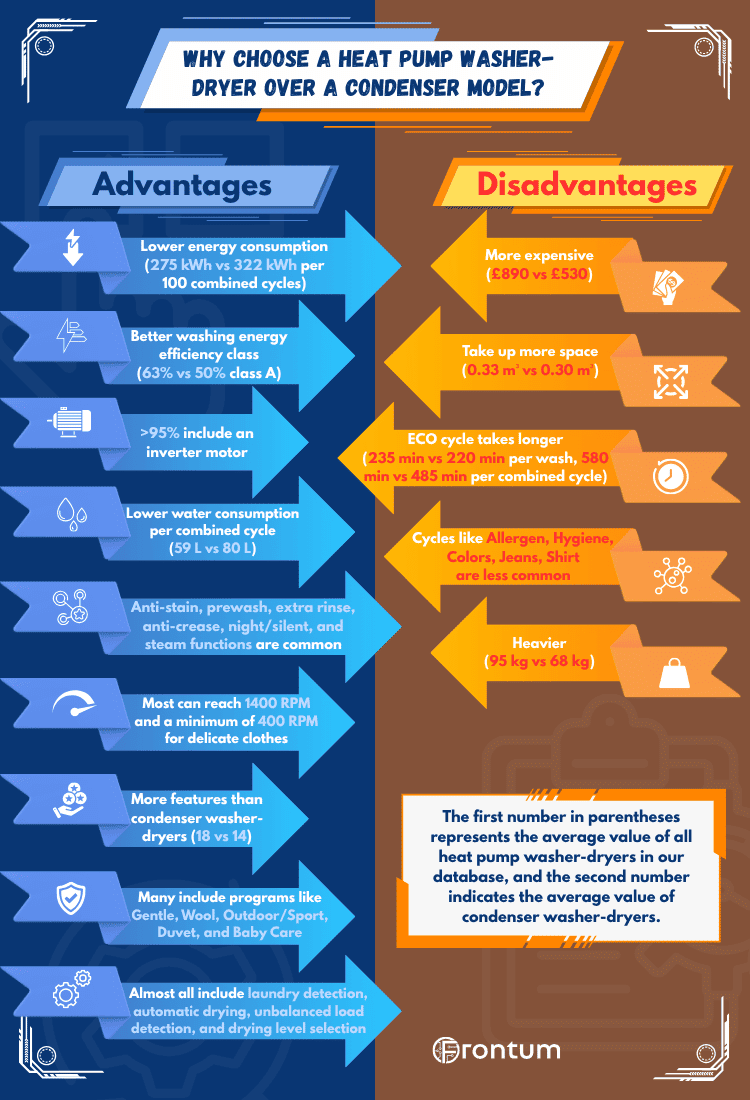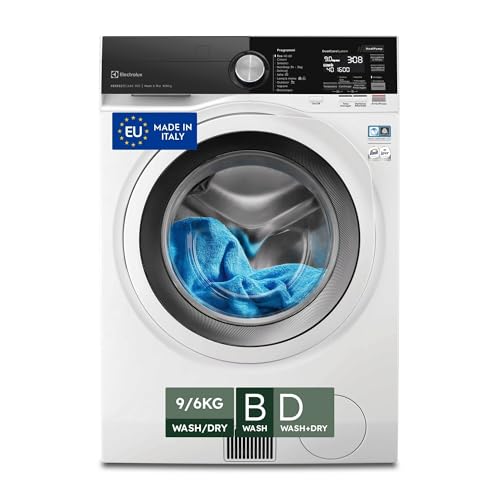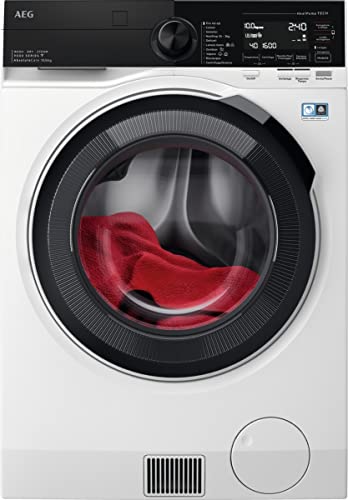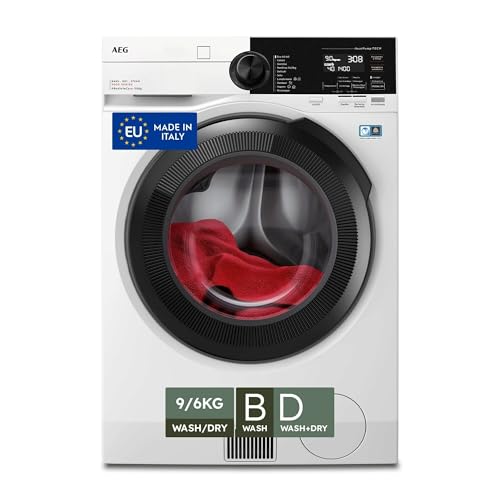Are heat pump washer-dryers good?
Heat pump washer-dryers have an average overall score of 7.1 and an average user rating of 6.5. Condenser washer-dryers have an average overall score of 7.4 and a user rating of 7.9.

What are the main advantages of heat pump washer-dryers?
Heat pump washer-dryers have the following advantages compared to condenser washer-dryers:
- Inverter motor in all models: All heat pump washer-dryers that we analysed include an inverter motor, which most condenser washer-dryers do not have.
- Lower energy consumption per 100 combined cycles: Heat pump washer-dryers consume on average 275 kWh per 100 combined cycles, while condenser washer-dryers consume 322 kWh.
- Better energy efficiency class in washing: Around 63% of heat pump washer-dryers reach class A for washing energy efficiency, compared to 50% of condenser washer-dryers.
- Lower water consumption per cycle: Heat pump washer-dryers use on average 59 litres of water per combined cycle, while condenser washer-dryers use 80 litres.
- Higher spin speed range: Most heat pump washer-dryers reach a spin speed of 1400 RPM or higher and have a minimum spin speed of 400 RPM, which suits delicate clothes.
- More specialised washing programs: Many heat pump washer-dryers include programs such as Gentle, Wool, Outdoor/Sport, Duvet and Baby Care, which many condenser washer-dryers do not have.
- More washing and drying functions: Heat pump washer-dryers include functions such as Anti-stain, Prewash, Steam function, Fast Cycle, Extra Rinse, Anti-crease, Night/Silent Option and Power Save Mode, which appear less often in condenser washer-dryers.
- Higher number of features: Heat pump washer-dryers have an average of 18 features, 4 more than the market average of condenser washer-dryers.
- More smart and automatic functions: Almost all heat pump washer-dryers include a laundry detection system, automatic drying, unbalanced load detection, delay start, selectable drying level, selectable drying time and Pause & Add function, while many condenser washer-dryers do not.
What are the main disadvantages of heat pump washer-dryers?
The disadvantages of heat pump washer-dryers compared to condenser washer-dryers are as follows:
- Higher purchase price: Heat pump washer-dryers cost on average £370 more than condenser washer-dryers (£920 vs £540)
- Fewer washing programs: Some programs such as Allergen, Hygiene and Colors appear less often in heat pump washer-dryers than in most condenser washer-dryers, and no heat pump washer-dryers include a Jeans or Shirt program
- Longer ECO cycles: ECO cycle in heat pump washer-dryers takes on average 15 minutes more per washing cycle (235 min vs 220 min) and 95 minutes more per combined cycle (580 min vs 485 min)
- Lower self-cleaning rate: Only about 38% of heat pump washer-dryers include a self-cleaning cycle, while 76% of condenser washer-dryers include it
- Missing convenience features: No heat pump washer-dryers include automatic drawer cleaning, antivibration design or a reversible door
- Heavier build: Heat pump washer-dryers weigh on average 27 kg more than condenser washer-dryers (95 kg vs 68 kg)
- Larger dimensions: Heat pump washer-dryers take up about 10% more space than condenser washer-dryers (0.33 m³ vs 0.29 m³)
How much do heat pump washer-dryers cost?
Heat pump washer-dryers usually cost from about £410 up to £1,450. The average price is around £920, which is about £380 more expensive than condenser dryers that cost about £540 on average.
You will likely pay more upfront for a heat pump washer-dryer compared to a condenser dryer, but this higher price reflects the technology inside. Heat pump models work with greater energy efficiency, which lowers running costs over time.
The price distribution for heat pump washer-dryers is shown in the following chart.
[vertical-chart-20998821076219796]
How energy-efficient are heat pump washer-dryers?
Heat pump washer-dryers are energy-efficient. Most models have washing energy efficiency class A (about 63%) or class B (around 38%). No models reach class C, D or E. This is better than condenser washer-dryers, where only about 47% have class A, 18% fall under class B, 19% under class C, 13% under class D and 3% under class E.
You will usually find combined energy efficiency classes in heat pump washer-dryers between A and D. Around 20% reach class A, about 40% fall into class C and another 40% into class D. No models have class B, E or F. In comparison, condenser washer-dryers show weaker results, with 1% at class B, 42% at class D, 452% at class E and 4% at class F. None reach class A or C.
On average, heat pump washer-dryers use about 57 kWh per 100 washing cycles (a bit more than condenser models, which use around 55 kWh), and about 275 kWh per 100 combined cycles (lower than condenser models, which average 322 kWh).
Water use in heat pump washer-dryers ranges from 46 to 69 litres per washing cycle (average 51 litres), slightly higher than condenser washer-dryers, which use around 48 litres. For combined cycles, water consumption ranges from 50 to 91 litres, averaging 59 litres (21 litres less than condenser washer-dryers, which average 80 litres).
Energy efficiency classes for heat pump washer-dryers are represented in the following chart.
[pie-chart-36666836256624772]
What is the spin efficiency class of heat pump washer-dryers?
Spin efficiency class in heat pump washer-dryers is usually either class A or B, with about 50% in each. These models perform better than condenser washer-dryers, where 13% belong to class A, 86% to class B, and 1% to class C.
Spin-drying efficiency class closely follows the maximum spin speed. In heat pump washer-dryers, maximum spin speed is either 1400 RPM or 1600 RPM (about 50% of models in each category). All heat pump washer-dryers we analyzed can also spin at a minimum of 400 RPM, so you can wash delicate clothes that need lower speeds.
You get better spin efficiency overall with heat pump washer-dryers compared to condenser models.
How loud are heat pump washer-dryers?
Heat pump washer-dryers are similar to condenser washer-dryers in terms of how loud they are.
Noise levels during different phases are as follows:
- Spin noise level: in heat pump washer-dryers range from 72 to 77 dB, with the average being 75 dB (same as condenser washer-dryers).
- Washing noise level: in heat pump washer-dryers usually range from 51 to 57 dB, with the average being 54 dB (same as condenser washer-dryers).
- Drying noise level: in heat pump washer-dryers usually range from 65 to 66 dB, with most having 66 dB, more than condenser washer-dryers that produce a drying noise level of 59 dB.
Noise emission classes in heat pump washer-dryers usually fall into Class A to C. You will most often see:
- Class B: around 63% of models
- Class A: around 25%
- Class C: around 13%
Heat pump washer-dryers generally have slightly worse noise emission classes than condenser washer-dryers. Among condenser models, 39% belong to Class A, 30% to Class B, 24% to Class C and 7% to Class D.
How many drying programs do heat pump washer-dryers offer?
Heat pump washer-dryers have 10–16 drying programs, with an average of 12 programs. This is 1 fewer than the average for condenser washer-dryers.
Most heat pump washer-dryers include basic programs such as Eco 40-60, Cottons, Synthetics, Mix, and Wash&Dry.
All models we analyzed include a Wool and Gentle program. Many of them also include the following specialized programs:
- Outdoor/Sport (~88% of products)
- Refresh (~88%)
- Duvet (~25%)
- Baby Care (~13%)
Some cycles appear less often in heat pump washer-dryers than in condenser models:
- Allergen (in ~38% vs 52% of condenser washer-dryers)
- Hygiene (in ~25% vs 48%)
- Colors (in ~13% vs 34%)
Only ~38% of heat pump washer-dryers include a self-cleaning cycle (condenser washer-dryers reach 76%).
We have not found any heat pump washer-dryer with a Jeans or Shirt program.
Washing Eco cycle in heat pump washer-dryers takes from 220 to 240 minutes (average 235 minutes), which is 15 minutes more than the average for condenser washer-dryers (220 minutes).
Combined Eco cycle (washing + cupboard drying level) in heat pump washer-dryers takes from 560 to 610 minutes, with an average of 580 minutes. That is 95 minutes more than condenser washer-dryers, which take 485 minutes on average.
Which drying functions heat pump washer-dryers have?
Heat pump washer-dryers have the following drying functions:
All heat pump washer-dryers in our database include some type of anti-stain function and also a Prewash program. Many of them also include the following functions:
- Steam function (~90%)
- Fast cycle option (~90%)
- Extra Rinse function (~90%)
- Anti-crease function (~90%)
- Night/Silent option (~50%)
- Power Save mode (~25%)
Only a few models include a Soak function. We have not found heat pump washer-dryers with the Water+ function, but this feature is rare in general.
Heat pump washer-dryers include from 13 to 25 advanced features. On average, they have 18 features, which is 4 more than the average condenser washer-dryer.
Almost all heat pump washer-dryers include features such as laundry detection system, automatic drying, unbalanced load detection, delay start option, selectable drying level, selectable drying times and Pause & Add Feature.
Other common features in heat pump washer-dryers are as follows:
- Acqua Stop (~75%)
- Foam control system (~75%)
- Favorite function (~50%)
- Smart diagnosis (~40%)
- Automatic load balancing during spin (~40%)
- Wi-Fi connectivity (~04%)
- AI Technology (~15%)
- Pre-mix technology (~15%)
- Automatic dosing system (~15%)
- Eco indicator (~15%)
All heat pump washer-dryers we analysed include an inverter motor.
~60% of models include a special drum design for delicate clothes and a few also include interior light.
We found no heat pump washer-dryers with automatic drawer cleaning. We also found no mention of antivibration design or reversible door.










